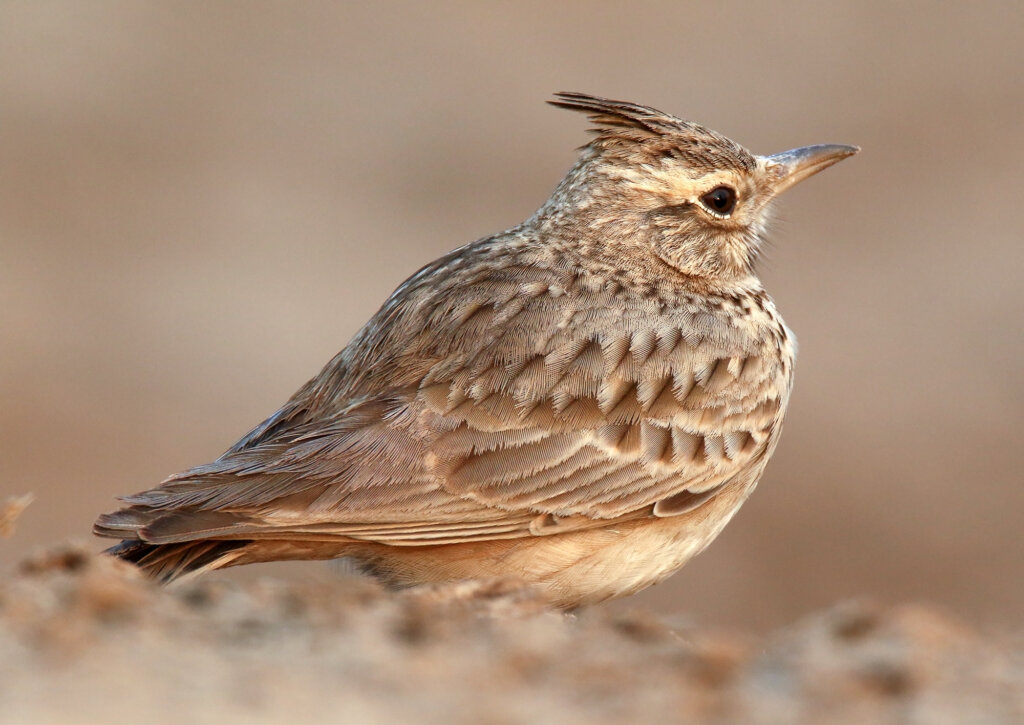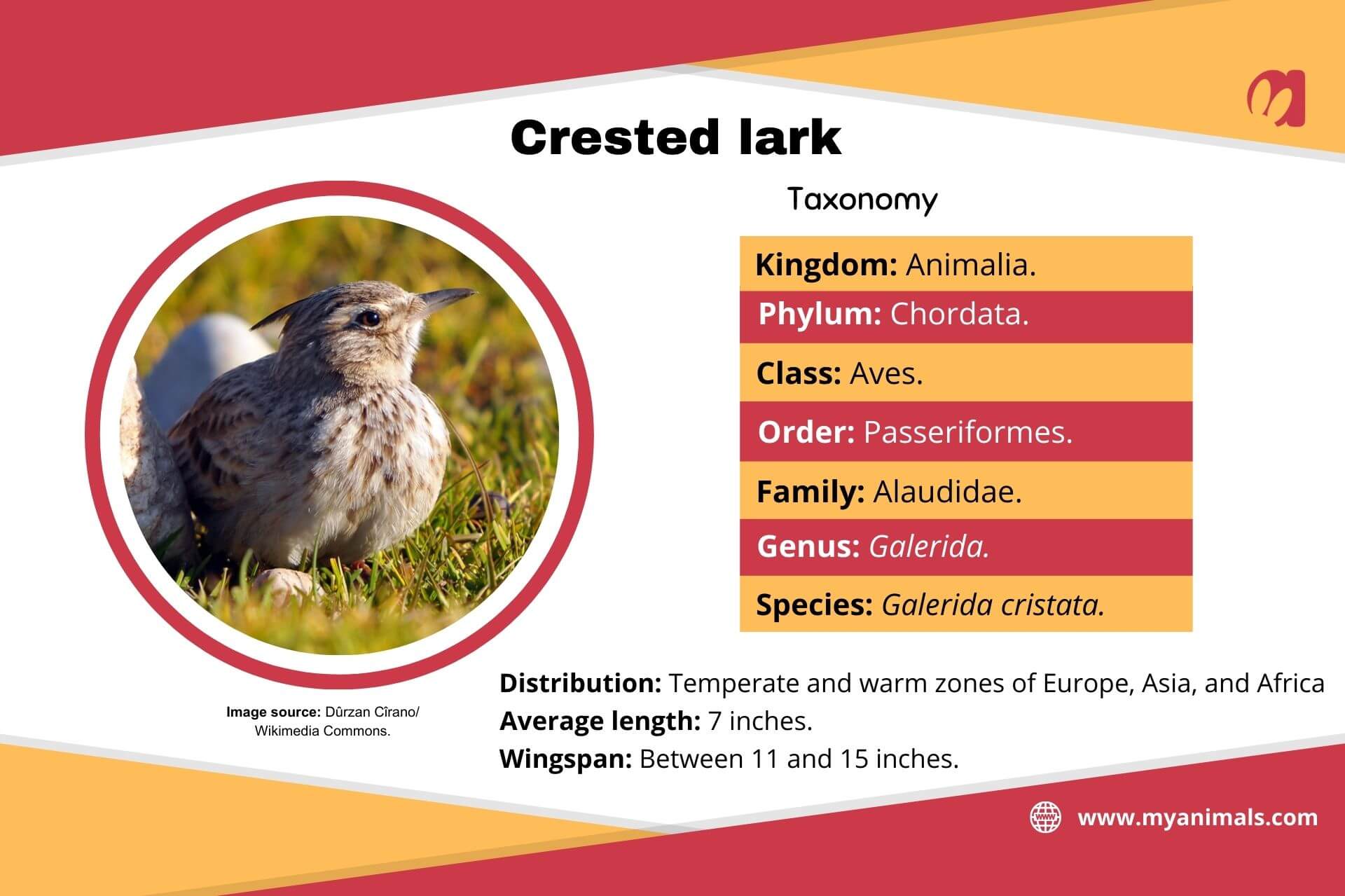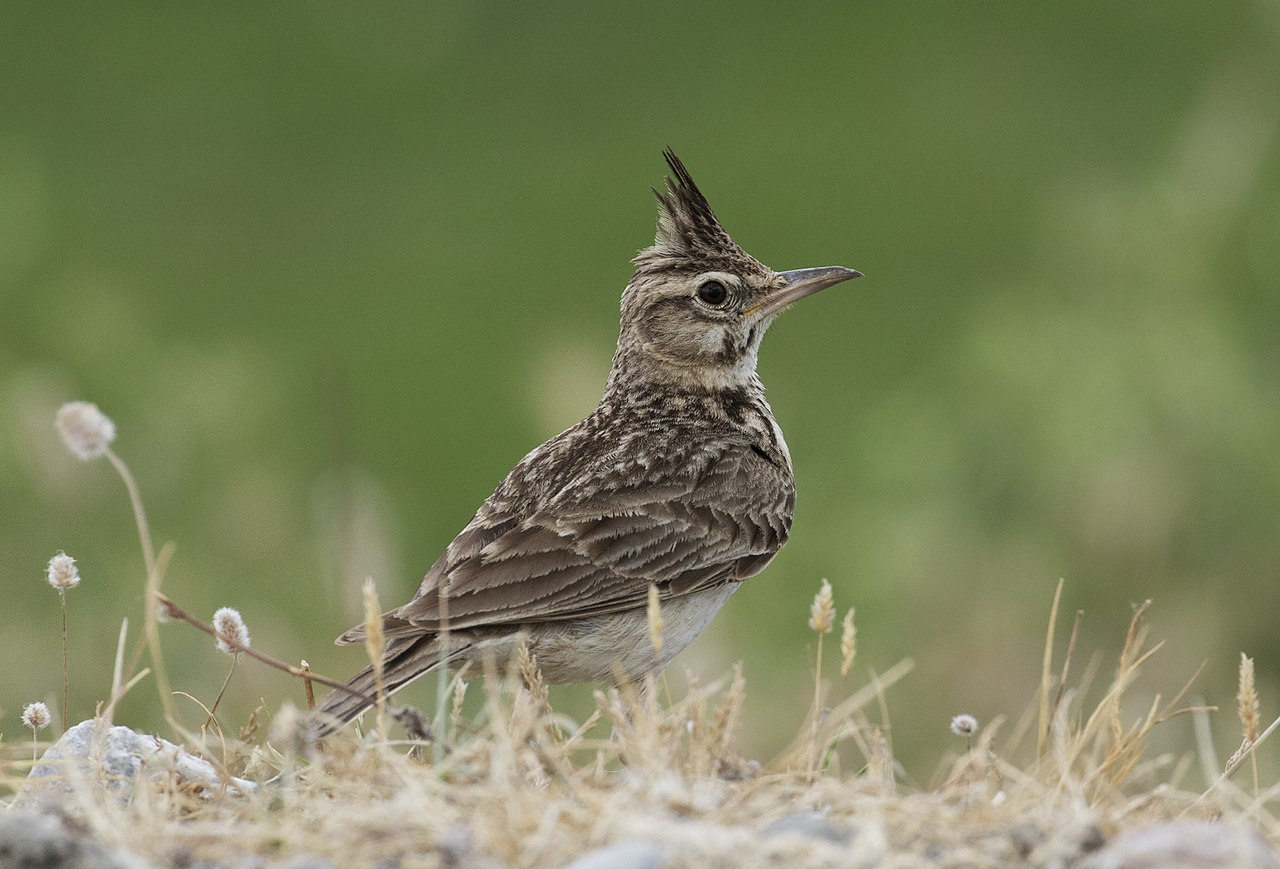The Crested Lark: Characteristics, Habitat, and Diet

Crested birds are a group of birds that owe their name to a special feature: A plume of feathers that adorns the top of the head, like a crest. They inhabit Europe, Asia, and Africa, where they delight us with their melodious songs. At present, there are seven specimens of similar appearance. Among them, we have the common Crested Lark or Galerida cristata, with a very wide distribution.
It belongs to the order of passerines or songbirds and to the family Alaudidae, with about 21 genres and 98 species. In the following article, we’ll present a description of the characteristics, lifestyle, and conservation status of this bird. We’ll also offer you some features that differentiate it from Thekla’s Lark.
The Habitat of the Crested Lark

This bird has a wide range of distribution, as it can be found in temperate and warm areas of Europe, Asia, and Africa. With respect to its habitat, it prefers dry places with little vegetation cover, including:
- Steppes
- Plains
- Semi-desert landscapes
It also adapts to other rural or suburban sites, such as rain-fed crop fields. Its upper altitude limit is 10500 feet. However, it likes to be at lower ranges.
A study of western Poland reported in the journal Bird Study highlights the preference of agricultural lands as habitats for this type of bird. These include silage sites and cereal crops.
Characteristics of the Crested Lark

This bird reaches a length of 17 inches and a wingspan of 11 to 15 inches. According to data from the Spanish Ornithological Society (SEO/BirdLife), it has the following characteristics:
- A slightly stocky body
- A large head
- A long and somewhat curved beak
- A short tail
It has a plumage of brownish tones on the upper part, while the lower part is lighter and cream-colored. Likewise, it has a peculiar design, in the form of dark stripes, both on its body and face.
These patterns and chromatic combinations offer some protection to this bird of terrestrial habits because they allow it to blend in with the ground.
As we’ve mentioned, the most striking aspect is its crest, which gives it an elegant appearance. In addition, this is the feature that gives the genus Galerida its name and distinguishes it from other birds lacking this ornament.
The song of the Crested Lark
Aukids are characterized by their melodious and complex sounds, so this species is no exception. Vocalizations are variable, some being soft and long, similar to a flute, and others shorter. Their songs can be a bit shrill.
Discover: Domestic Birds that Sing the Most
Differences between the Crested Lark and Thekla’s Lark
The Crested Lark and Thekla’s Lark (Galerida theklae) are very distinguishable from other members of their family(Alaudidae). However, telling them apart from one another can be a rather complicated task, even for experts. This is because they’re very similar in appearance. Despite this, there are some discrepancies between these two galerida. These are the following:
- Beak: The bill of the Crested Lark is a little longer and curved, while that of Thekla’s Lark is straighter and more pointed.
- Crest: The crest of Thekla’s Lark is shorter and bushy. On the other hand, the crest of the Crested Lark is somewhat longer and pointed.
- Breast stripe pattern: More intense in Thekla’s Lark and diffuse in the Crested Lark.
- Color of the upper caudal feathers: They have a gray or reddish-brown tone, which offers a greater contrast with the rump and the grayish-brownish tail in Thekla’s Lark. On the other hand, in the Crested Lark, there’s no color on the upper caudal feathers. At the same time, in the Crested Lark, the chromatic differences in this part of the body are less noticeable.
- Preference of perching site: While the Crested Lark tends to spend more time on the ground, Thekla’s Lark likes plants more.
- Habitat: The Crested Lark is located in places with more pastures and crops that are associated with the presence of humans, while Thekla’s Lark prefers more shrubby areas, away from humans.
- Song: Although the melodies of both species are similar, those of the Crested Lark have more varied, high-pitched sounds, with shorter and more strident pauses. The song of Thekla’s Lark is usually more melodious.
What does the Crested Lark eat?
The Crested Lark is an omnivorous bird, so it can consume both plant material and animals (invertebrates). In the first case, these include the following:
- Plant seeds
- Leaves
- Green shoots
A 2005 publication in the journal Zoology in the Middle East refers to the diet of the Crested Lark during autumn in Iran. It states that this species includes the following insects in its diet:
- Coleoptera (beetles)
- Orthoptera (grasshoppers and crickets)
- Formicidae (ants)
Reproduction
The Crested Lark is a monogamous species that can have two breeding seasons per year. The nest is built in a depression in the ground, either covered with a shrub or in the open air. The materials used include grass or any other type of plant component, such as the following:
- Moss fragments
- Dry grass
- Leaves
- Sticks
It should be noted that the aforementioned spaces aren’t the only ones these birds choose to lay their eggs, which usually range from 3 to 5. In addition to natural habitats, these crested birds can also nest near human settlements.
In fact, in the chapter entitled Green Roofs-Urban Habitats for Ground-Nesting Birds and Plants in the book Urban Biodiversity and Design, the authors refer to the case of Switzerland, where several species -including the Crested Lark- have made their nests on rooftops.
Ground-nesting birds seem to have adapted to breeding on extensive flat roofs rather than agricultural areas.
– Nathalie Baumann and Friederike Kasten –
Also read: Dupont’s Lark: Conservation of the Species
Conservation status
The Galerida cristata isn’t threatened with extinction. The International Union for Conservation of Nature (IUCN) classifies it as “Least Concern” globally and in Europe. This report is based on the wide distribution of the specimen.
However, its population is in a declining state -although not in alarming numbers-, due to the decrease in the number of individuals in recent years. The main threats are the following:
- Agricultural and fertilization practices
- The use of pesticides
- Urbanization, accompanied by afforestation practices
- Climate change
A crest to distinguish itself and colors for camouflage
The Crested Lark is a bird with inconspicuous colors, but they serve to camouflage the bird on the ground. It also has a crest that adorns its head by which it can be easily distinguished from other species. We invite you to continue getting to know more members of the Alaudidae family, which, although similar, have different and interesting aspects in their lives.
All cited sources were thoroughly reviewed by our team to ensure their quality, reliability, currency, and validity. The bibliography of this article was considered reliable and of academic or scientific accuracy.
- Baumann, N., & Kasten, F. (2010). Green roofs: urban habitats for ground-nesting birds and plants. In N. Müller, P. Werner, & J. G. Kelcey (Eds.), Urban Biodiversity and Design (pp. 348–362). https://www.researchgate.net/publication/325131127_Green_Roofs_-_Urban_Habitats_for_Ground-Nesting_Birds_and_Plants
- BirdLife International. (2019). Galerida cristata (amended version of 2017 assessment). The IUCN Red List of Threatened Species 2019: e.T22717383A155503110. https://www.iucnredlist.org/species/22717383/155503110
- BirdLife International. (2021). Galerida cristata (Europe assessment). The IUCN Red List of Threatened Species 2021: e.T22717383A166394681. https://www.iucnredlist.org/species/22717383/166394681
- Carrascal, L. M. & Palomino, D. (2008). Las aves comunes reproductoras en España. Población en 2004-2006. SEO/BirdLife. Madrid. https://seo.org/wp-content/uploads/2012/06/19avescomunes.pdf
- Cobo, J. (2023). Cogujada montesina – Galerida theklae. En: Enciclopedia Virtual de los Vertebrados Españoles. López, P., Martín, J., Traba, J. (Eds.). Museo Nacional de Ciencias Naturales, Madrid. https://digital.csic.es/bitstream/10261/308464/3/galthe_v1.pdf
- Khalehizadeh, A., Golshekan-Tatafi, M., Youzbashi, M., & Aghabeigi, F. (2005). Autumn diet of the Crested Lark, Galerida cristata, in Iran. Zoology in the Middle East, 35(1), 106-107. https://www.tandfonline.com/doi/abs/10.1080/09397140.2005.10638112
- Lisiecki, M., Dylewski, Ł., Kistowska, B. E., & Tobółka, M. (2020). The Crested Lark Galerida cristata as an example of a bird species that benefits from agricultural management in western Poland. Bird Study: The Journal of the British Trust for Ornithology, 67(2), 197–205. https://doi.org/10.1080/00063657.2020.1808589
- Orban, Z. (2004). Nest construction and roosting behaviour of a Crested Lark Galerida cristata population nesting on flat roofs in Hungary. Ornis Hungarica, 14, 1-13. http://www.ornis.hu/articles/OrnisHungarica_vol14_p1-13.pdf
- Sociedad Española de Ornitología SEO/BirdLife. (s.f.). Cogujada común. Consultado el 10 de junio de 2023. https://seo.org/ave/cogujada-comun/
- Universidad de Málaga. (s.f.). Cogujada común (Galerida cristata). Consultado el 10 de junio de 2023. https://www.umadivulga.uma.es/museo-virtual/zoologia/vertebrados/aves/cogujada-comun-galerida-cristata/
